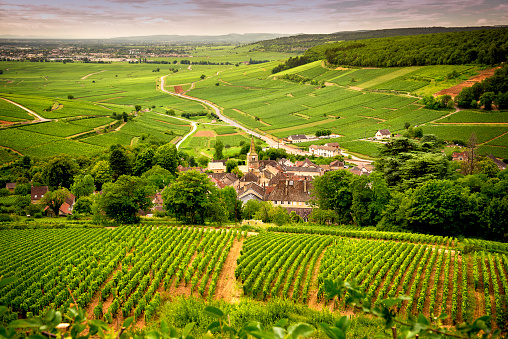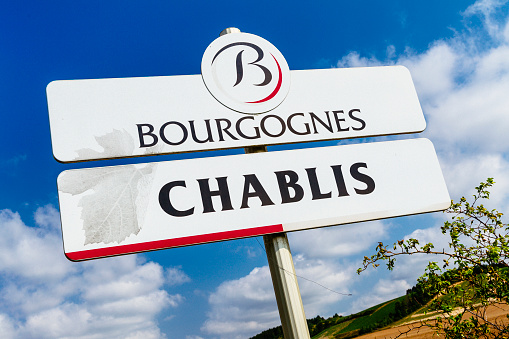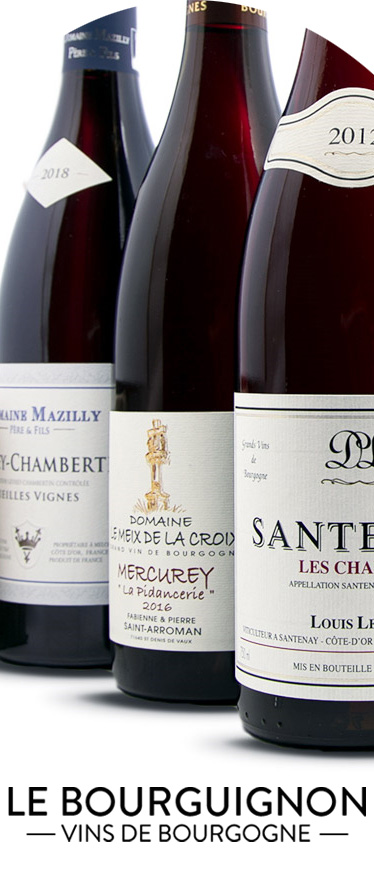The department of Yonne (89) consists of Chablis and the great Auxerrois (a clover with four leaves: Auxerrois, Jovinien, Vézelien and Tonnerrois), the wine region there further north of Burgundy.
The landscapes are magnificent between valleys, plateaus and hills… it is an archipelago of small vineyards (Joigny, Saint-Bris, Vézelay, Irancy, Epineuil) crowning a king, Chablis, whose vines marry all the exhibitions.
At the beginning of the Middle Ages, the Yonne department was the main supplier of wine to the Parisian market. It is in the seventh century, that the production of Auxerre but also Chablis supply the capital, Normandy and the north of the country. Mainly in white wine but also in red wine (from the fourteenth century).
Chablis and the great Auxerrois are based on geological terroirs of the Jurassic (some 150 million years old) and kimmeridgian where limestone clays, marls and marl limestones alternate (50 to 100 meters thick). Also Portlandian or Barrois limestone, hard and compact, often cracked.
Natural disasters
From the eighteenth century, Chablis was recognized as a qualitative wine. It became the essential wine of the elegant tables of Paris. He was advised by the team of the restaurant "Au Rocher de Candale", a true myth of Parisian catering. In the nineteenth century, most of the restaurants in the capital sold Chablis. It occupies an important place in the history of France.
Unfortunately in 1902 French winegrowers lost 15% of their production due to phylloxera. It was even worse in the Yonne, following severe spring frosts that destroyed more than 45% of the crops (they destroyed almost all the plantations between 1957 and 1961). Never again will the vineyard be the same as before… That's why farmers have replaced the vine with cherry trees and cereals.
However, in 1961, winemakers such as André Durand in Epineuil, Henri Nallet in Tonnerre, William Fèvre and Jean Durup in Chablis were motivated to replant vines. Together they decided to plant seedlings on the hillsides most suitable for cultivation.
In order to fight against spring frosts, winemakers have set up heaters, which warm the atmosphere. It is a type of brazier, they are arranged every seven meters, or 200 burners per hectare in order to keep the ambient air at a temperature above 0 ° C. Its negative points are:
- the cost (they burn 600 liters of fuel per hour per hectare)
- pollution
- the implementation
Other winegrowers sprinkle water on the vines, they are nozzles that send a fog in order to form a "cocoon" of insulating ice around the bud, they are then protected. They also use paraffin candles, electric heating cables.
Climate change is disrupting vineyards, excessive heat is causing yields to fall, weakening vines and precipitating harvests.
After several nights of fighting frost that have exhausted the winegrowers, the weather looks milder. The damage seems limited, the vine is only at the beginning of its development. But the road is still long until May… #LaVigneContinue #VinsBourgogne #Chablis pic.twitter.com/61ehwxoXC2
— Chablis wines (@vinsdechablis) April 2, 2020
Today, the Yonne department totals 7,000 hectares of vines.
Grape varieties

Chardonnay is king
It is the most cultivated white grape variety of Burgundy and historic Chablis, locally called Beaunois. Its wines particularly express minerality (flint, pebbles, gun stone,…) which comes from its Kimmeridgian limestone terroir.
Sauvignon
It is found only on Saint-Bris-le-Vineux. It was popularized in the nineteenth century by Parisian bistros lovers of charming and very aromatic wines. It is recognized by its compact clusters of a beautiful golden yellow.
Aligoté
This lively grape variety gives lemon wines and does well in Chitry.
Yonne is one of the only wine departments to have preserved some old grape varieties:
Sacy
This grape variety is disappearing, some winegrowers continue to plant it to produce crémants de bourgogne.
Melon (from Burgundy)
It is the traditional grape variety of Vézelay, it is allowed only in regional Burgundy appellation (and not in Burgundy Vézelay), it can also be called Muscadet (mainly in the Nantes region).
Pinot Noir
Pinot Noir is known for its great red wines of Burgundy, however in Chablis, it is very little planted since it struggles to give pleasant wines. On the other hand, this grape variety is very appreciated on the terroir of the AOC irancy, predominantly very limestone, it produces cuvées of beautiful hold. Global warming favors the blossoming of Pinot Noir.
Caesar
The Caesar was very appreciated in the nineteenth century (it would have been brought by the Roman legions) less now because vinified alone, it remains austere and very colorful. However it is authorized up to 10% for the Irancy appellation where it brings a beautiful structure. This is a local peculiarity.
Gamay
This grape variety , which appreciates siliceous and granitic soils, is not very widespread in the Yonne because this type of soil is rare.
***
In Burgundy, the different plots determine a regional, communal, premier cru and grand cru appellation according to their geographical location.
Hierarchy of appellations in Burgundy
In order to better navigate, its 83 appellations have been divided into 4 levels:
- Grands Cru appellations
- Premiers cru appellations
- Communal appellations (villages)
- Regional names (sometimes called "generic" or "sub-regional")
Chablis and the great Auxerrois
| The Grands Crus of Burgundy are at the top of the hierarchy since they have the best exposures and the most favorable microclimates . They are big names known internationally. |
The seven "climates" of the Chablis Grands Crus (the Chablis Grand Cru AOC was created on January 13, 1938):
- Blanchot
- Bougros
- Frogs
- The Clos
- The Preuses
- Valmur
- Vaudésir
|
The term "climate" refers to plots of land in Burgundy. This word takes into account the know-how of the winegrowers, the geological characteristics, the particular exposures where each plot is precisely delimited. |
•
| The first growths of Burgundy are below the grands crus but they remain great wines as well. Each bottle is followed by the name of the plot and respects strict specifications (spacing between vines, pruning,…). |
The 41 "climates" in Premier Cru of the Chablis appellation:
- Berdiot
- Talvat thatch
- Jouan Coast
- Jouan Coast
- Coast of Léchet
- Vaubarousse Coast
- Furnace
- Fontenay Coast
- The Dead Man
- Vaulorent
- Vaupulent
- The Beauregards
- Cuisy Coast
- The Stoves
- Côte des Prés-Girots
- Morein
- Mont de Milieu
- Ascent of Thunder
- Rosary
- Bréchain Coast
- Pied d'Aloup
- Montmains
- Mounds
- Forests
- Vaillons
- Beugnons
- Kittens
- the Epinottes
- The Lilies
- Melinos
- Roncières
- Dry
- Vau de Vey
- Vaux Ragons
- Vau Ligneau
- Vaucoupin
- Vosgos
- Vaugiraut
•
| The communal appellations of Burgundy correspond to the name of the village where the plot is located. |
Chablis and the greater Auxerrois offer four communal appellations :
- Chablis
- Petit-chablis
- Irancy
- Saint-Bris
These communal appellations can be followed by the name of its "climate" (explained above) that characterizes the controlled designation of origin.
=> The Vézelay appellation has applied to the National Institute of Origin and Quality (INAO), the file is currently being examined. 🔍
The difference between windfall and small windfall:
The Chablis appellation (the largest of the vineyard) is produced in the communes of:
- Beines
- Beru
- Chablis
- Fyé
- Milly
- Poinchy
- La Chapelle-Vaupelteigne
- Chemilly
- Chichée
- Collan
- Courgis
- Fleys
- Fontenay
- Lignorelles
- Ligny
- Maligny
- Poilly
- Prehy
- Villy
- Fish ponds
Its wines come from a blend of several plots and its soils are of great diversity: mainly Kimmeridgian limestone, with clay, Colluvium of Portlandian limestone or marl.
The appellation petit chablis is spread over all the communes of the Chablisien and covers mainly the plateaus made of Portlandian limestone.
•
These Burgundy regional appellations are produced in Chablisien and Yonne:
- Burgundy
- Burgundy Aligoté
- Burgundy Passe-Tout-Grains
- Sparkling Burgundy
- Burgundy Hillsides
- Crémant de Bourgogne
Regional Burgundies can be associated with a village name (Bourgogne Epineuil, Bourgogne Côte d'Auxerre, Bourgogne Chitry, Bourgogne Coulanges,…), they are pleasant wines and typical of their terroirs.
The vineyards of Chablis and the great Auxerrois offer remarkable wines!
Chablis
Chablis is the golden gateway to Burgundy (which is located between Paris and Beaune), it covers the most beautiful coasts such as Fourchaume, Montée de Tonnerre or Mont de Milieu. This famous vineyard occupies 5,641 hectares of vines (surface in 2018) known since the Cistercian era.
This appellation is dedicated to Chardonnay (a single color: white), with predominantly calcareous, stony soils and Jurassic marls (Portlandian and Kimmeridgian), more conducive to the grape variety generating fine and solid wines. Well exposed to the sun on both sides of the small valley of the Serein.
Windfalls and small windfalls are oriented to the north, south, west and east. As for the chablis premier cru they are oriented to the south-east, facing the grands crus which are exposed to the south-west.
[Vines and wines] He ploughs plots of great #Chablis wines to the rhythm of horses #Yonne #vin >>https://t.co/UqYgBI5erZ pic.twitter.com/JVdSdDPvpZ
— L'Yonne Républicaine (@lyonne_fr) October 4, 2020
Chablis are synonymous with great dry white wine renowned all over the world!
The small chablis have a light and bright gold color, with aromas of white flowers (acacia,…), mixed with citrus notes (lemon, grapefruit,…), the mouth is tasty and light.
Chablis express lively, fresh, light, fruity white wines (lemon,…) and of great clarity. He has a unique personality.
The premiers crus have a wide aromatic palette of white flowers (hawthorn,…), fresh fruit (pear, green apple,…) and dried fruits (hazelnut, almond,…) after three to four years of bottles the mineral aromas (pebbles ,…) develop and a touch of freshness surprises the taste buds. It's a joy! These wines have a good ability to age.
The chablis grands crus reveal a charming fragrance, a remarkable elegance, embodying minerality (gun stone, flint,…) par excellence. Very good ageing capacity (up to 20 years and more for some climates), during aging the wine will be more corpulent, longer flavors and intense aromas. It's a haute couture wine !
These appellations combine wonderfully with seafood, fish in sauce, white meats (poultry,…) and for the most prestigious with foie gras! You will not be disappointed.
Chablis is a connoisseur's wine!
What if we went to admire the chablis vineyard from the sky? 🚁https://t.co/3ed5kSCRlj #chablis #vinsdechablis #vigneron #vignoble #bourgogne #vigneron
— Chablis wines (@vinsdechablis) September 28, 2020
The great Auxerrois
To the north-west of Chablis, the great Auxerrois is given to the vineyards of the Yonne (excluding Chablis) which run along the rivers of Serein, Armançon and Yonne. A production of white wine (55%), red wine (24%), Crémant de Bourgogne (19%) and rosé (2%). Consisting of four terroirs (with an area of 1,963 hectares):
- L'Auxerrois (south and south-east of the city of Auxerre)
- Le Tonnerrois (near the town of Auxerre)
- The Vézelien (covers the communes of Vézelay, Asquins, Saint-Père and Tharoiseau)
- The Jovinien (dominates the city of Joigny)
The great Auxerrois supplies by river, the capitals of Europe via Paris, its wines of regional appellations of a great diversity (white, red, rosé or sparkling). They reserve surprises for lovers of pleasant wines.
Its main appellations are located on the predominantly limestone hillsides, its climate is semi-continental (long and cold winters, humid springs and hot summers). The optimal altitude is between 130 and 250 meters and the best vines are exposed to the southwest.
Discover the Auxerre vineyard with "Le Clos de la Chaînette"the + old vine of France https://t.co/AqPMdXRMRD pic.twitter.com/hgsQxhZOGG
— Germain Bour (@BourGermain) December 6, 2015
The outlying vineyards of the Yonne offer niche wines such as Irancy for its red wine and Saint-Bris-les-Vineux for its Sauvignon.
.
Irancy
This communal appellation created on February 28, 1999, is cultivated in three communes about fifteen kilometers from Auxerre :
- Irancy
- Cravant
- Vincelotte
Irancy produces exclusively red wine, during its elaboration, two grape varieties are used: Pinot Noir and Caesar (maximum 10%). Its soil benefits from limestone marls, favorable to grape varieties.
The wines of the appellation #Irancy have a unique feature in #Bourgogne : they can contain up to 10% César (traditional grape variety of the village) in addition to the #PinotNoir. An AOC that is worth a visit: https://t.co/hfT6BRPsnx@YonneTourisme @OTAuxerrois pic.twitter.com/CQRJ4YDp28
— Burgundy wines (@VinsdeBourgogne) October 4, 2020
Irancy is characterized by its colorful color, fruity aromas, fine tannins and firmness. Caesar gives it a good ability to preserve. It can be offered with white meat, soft cheeses or as an aperitif with friends.
Saint-Bris
This appellation is created by decree on January 10, 2003, it produces only white wine (grape varieties : Sauvignon and Sauvignon Gris) within the delimited area of the Saint-Bris appellation.
In Saint-Bris-le-Vineux, these are marl slopes of the middle and upper Kimmeridgian . When we look at it more closely we see deposits of tiny oysters in the shape of commas, called exogyra virgula. It's unbelievable.
This wine has a very pale color, a yellow tinged with green. Its very expressive nose, is characterized by a smell of crumpled blackcurrant leaf, aromas of exotic fruits (pineapple,…), fresh grass, vegetables (pepper,…). In the mouth, the attack is frank and of a beautiful balance.
At mealtime, this wine can be enjoyed with oysters, seafood, cold cuts or snails. 





